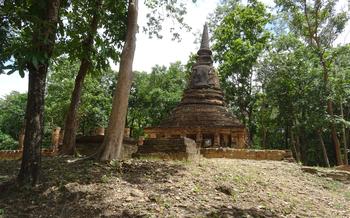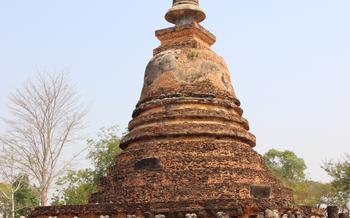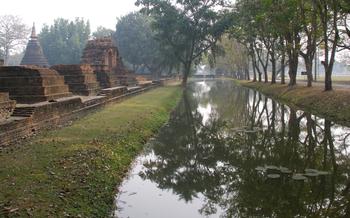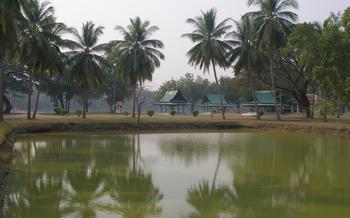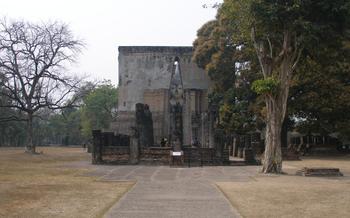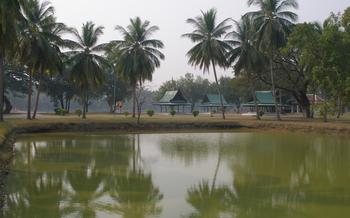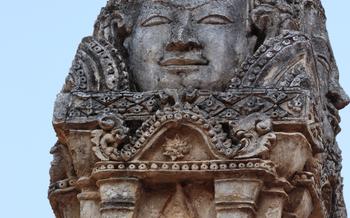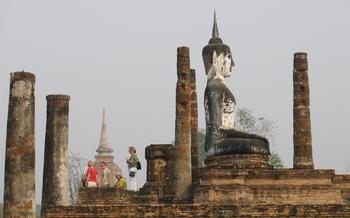
Thuriang Kilns
- Thuriang Kilns: A Historical Overview
- Getting to the Thuriang Kilns
- Exploring the Kiln Complex
- Unveiling the Ceramics Production Process
- Witnessing the Craftsmanship of Sukhothai Ceramics
- Interactive Displays and Exhibits
- Immersive Experience of a Working Kiln
- Shopping for Sukhothai Ceramics
- Exploring the Surrounding Area
- Cultural Performances and Events
- Best Time to Visit
- Photography Opportunities
- Budget and Cost Considerations
- Responsible Tourism Practices
- Insider Tip: Hidden Gem Nearby
Thuriang Kilns: A Historical Overview
The Thuriang Kilns, nestled in the heart of Thailand's Sukhothai Historical Park, hold a profound historical significance. Dating back to the 13th century, these ancient kilns bear witness to the flourishing ceramics industry of the Sukhothai Kingdom, a period renowned for its artistic and cultural achievements. Archaeological excavations at the site have unearthed a treasure trove of artifacts, including shards of exquisite ceramics, providing invaluable insights into the production techniques and artistry of the era. The Thuriang Kilns stand as a testament to the ingenuity and craftsmanship of the Sukhothai people, showcasing their mastery in the art of ceramics.
Getting to the Thuriang Kilns
The Thuriang Kilns are conveniently located just a short distance from the city of Sukhothai, making them easily accessible for visitors. To reach the kilns, you can either take a leisurely bike ride or opt for a tuk-tuk, a traditional Thai mode of transportation, which offers a unique and immersive experience. The journey from Sukhothai city to the kilns takes approximately 30 minutes, providing an opportunity to admire the tranquil countryside scenery along the way. Once you arrive at the kilns, you'll be greeted by the sight of ancient structures and lush greenery, setting the stage for an unforgettable journey into the past.
Exploring the Kiln Complex
The Thuriang Kilns complex offers a fascinating glimpse into the ancient ceramic production process. As you wander through the site, you'll encounter the remains of kilns, chimneys, and pottery shards scattered throughout the area. These remnants provide a tangible connection to the past and allow you to visualize the bustling activity that once took place here.
The layout of the kiln complex is well-preserved, with clearly defined areas for different stages of ceramic production. You can trace the journey of clay from its initial preparation to its transformation into exquisite pottery. Guided tours are available for those who wish to delve deeper into the history and significance of the site. However, self-exploration is also encouraged, allowing you to wander at your own pace and absorb the atmosphere.
Unveiling the Ceramics Production Process
The Thuriang Kilns offer a glimpse into the ancient ceramics production process, showcasing the ingenuity and skill of Sukhothai potters. These kilns employed various techniques to create stunning ceramics, including celadon and stoneware.
Celadon, a type of glazed stoneware, was a specialty of the Sukhothai Kingdom. The potters used a unique firing technique to achieve the characteristic green or blue-green glaze, which resulted from the reduction of iron oxide in the clay during the firing process.
The kilns themselves were carefully designed to regulate temperature and airflow. The structures featured multiple chambers, allowing for efficient firing and cooling of the ceramics. The potters skillfully controlled the temperature and duration of firing to achieve the desired results.
In addition to celadon, the Sukhothai potters also produced a variety of stoneware, which involved different clays and firing techniques. These ceramics were often decorated with intricate designs and patterns, demonstrating the artistry and creativity of the artisans.
Exploring the kiln complex, visitors can observe the remains of kilns, chimneys, and pottery shards, which provide tangible evidence of the ceramic production process. Guided tours and self-exploration allow visitors to delve deeper into the history and techniques of Sukhothai ceramics.
Witnessing the Craftsmanship of Sukhothai Ceramics
Sukhothai ceramics are renowned for their exceptional quality and intricate designs. The potters of Sukhothai possessed extraordinary skills and artistry, which are evident in the stunning ceramics they produced. Their mastery of techniques such as glazing, firing, and decoration resulted in ceramics that were both functional and aesthetically pleasing.
The potters of Sukhothai drew inspiration from their surroundings, incorporating elements of nature and local culture into their designs. They created a wide range of ceramics, including celadon, stoneware, and decorative items. Each piece was meticulously crafted, showcasing the potter's skill and attention to detail.
Celadon, with its distinctive green glaze, was a particularly popular type of ceramic produced in Sukhothai. The potters achieved this unique glaze by applying a thin layer of iron oxide to the clay before firing. The resulting color was highly prized and became a defining characteristic of Sukhothai ceramics.
The legacy of Sukhothai ceramics lives on today. Many potters in Thailand and around the world draw inspiration from the ancient techniques and designs of Sukhothai. These ceramics continue to be celebrated for their beauty, craftsmanship, and historical significance.
Interactive Displays and Exhibits
At the Thuriang Kilns, you can delve deeper into the fascinating world of ceramics through interactive displays and exhibits. Educational panels provide detailed information on the ceramic production process, from sourcing raw materials to shaping and firing the clay. Artifacts and replicas of pottery tools and equipment showcase the techniques and artistry of Sukhothai potters.
The highlight of the exhibits is the hands-on activities that allow you to experience the ceramic-making process firsthand. You can try your hand at shaping clay on a potter's wheel, decorate a piece of pottery with traditional motifs, or experiment with different firing techniques. These interactive elements make the visit to the Thuriang Kilns a truly immersive and educational experience.
Immersive Experience of a Working Kiln
For a truly immersive experience of Sukhothai's ancient ceramic tradition, don't miss the opportunity to witness a working kiln in action. Skilled craftsmen demonstrate traditional firing techniques, using the same methods employed by their ancestors centuries ago. Observe the careful loading of the kiln, the intricate arrangement of fuel, and the precise temperature control. The firing process, which can take several days, transforms the raw clay into beautiful and durable ceramics, just as it did in the days of the Sukhothai Kingdom. This unique insight into the ancient craft provides a deeper appreciation for the skill and dedication of Sukhothai potters and the enduring legacy of their remarkable creations.
Shopping for Sukhothai Ceramics
At the Thuriang Kilns, you can not only witness the process of ceramic production but also take home a piece of Sukhothai's rich heritage. Local shops in the vicinity of the kilns offer a variety of authentic Sukhothai ceramics, providing an opportunity to support local artisans and preserve the tradition.
From exquisite celadon wares with their distinctive green glaze to durable stoneware pieces, you'll find a treasure trove of ceramic products to choose from. Decorative items, such as vases, bowls, and figurines, showcase the intricate designs and patterns that have made Sukhothai ceramics famous.
By purchasing these ceramics, you not only acquire beautiful souvenirs but also contribute to the sustainability of this ancient craft. The income generated from sales helps support local artisans, enabling them to continue practicing their skills and passing on their knowledge to future generations.
So, as you explore the Thuriang Kilns, don't miss the opportunity to delve into the world of Sukhothai ceramics, both as a cultural experience and as a way to take home a piece of this ancient tradition.
Exploring the Surrounding Area
Beyond the Thuriang Kilns, the region of Sukhothai is a treasure trove of historical and cultural wonders. A short distance away lies the Historical Park of Sukhothai, a UNESCO World Heritage Site that showcases the grandeur of the ancient kingdom. Explore the ruins of temples, palaces, and fortifications, marveling at the architectural prowess of the Sukhothai people.
In the vicinity of the kilns, you'll find a cluster of ancient temples that offer a glimpse into the religious and spiritual life of the Sukhothai era. Visit Wat Mahathat, the largest and most impressive temple in the park, with its towering prang (spire) and intricate stone carvings. Admire the serene beauty of Wat Si Chum, home to a colossal Buddha image exuding an aura of tranquility.
Combine your visit to the Thuriang Kilns with a broader exploration of Sukhothai's historical and cultural heritage. Discover the stories behind the ruins, immerse yourself in the local traditions, and appreciate the enduring legacy of this remarkable kingdom.
Cultural Performances and Events
Your visit to the Thuriang Kilns can be enriched by experiencing the vibrant cultural performances and events that Sukhothai has to offer. Traditional Thai dance and music performances showcase the grace and artistry of the local culture. These captivating shows often take place in the evenings, providing a delightful way to immerse yourself in Sukhothai's rich heritage.
Cultural festivals and workshops are also held throughout the year, offering visitors a chance to delve deeper into the local traditions. These events feature demonstrations of traditional crafts, folk games, and culinary delights. Participating in these activities provides an authentic and interactive way to learn about Sukhothai's diverse cultural heritage.
Attending cultural performances and events is not just a form of entertainment; it's also a way to support the local community. By participating in these activities, you contribute to the preservation and promotion of Sukhothai's unique cultural identity.
Best Time to Visit
The best time to visit the Thuriang Kilns is during the cool and dry season, which runs from November to February. During this period, the weather is pleasant, with average temperatures ranging from 20 to 25 degrees Celsius, making it ideal for outdoor exploration. Additionally, the crowd levels are generally lower during this time, allowing you to enjoy a more peaceful and immersive experience.
It's worth noting that the Thuriang Kilns are open year-round, but the weather conditions during the rainy season (May to October) can be unpredictable, with occasional heavy downpours and high humidity. However, if you are visiting during this time, be prepared for rain and carry an umbrella or raincoat.
To enhance your experience, plan your visit to coincide with one of the cultural festivals or events held in Sukhothai. These events often showcase traditional Thai dance and music performances, local crafts and products, and provide a glimpse into the rich cultural heritage of the region.
Photography Opportunities
Amidst the ancient ruins and lush greenery, the Thuriang Kilns present a captivating backdrop for photography enthusiasts. Capture the beauty of the towering chimneys, the intricate designs on pottery shards, and the serene landscapes that surround the complex. Whether you're a professional photographer seeking unique shots or a casual traveler looking to document your journey, the kilns offer ample opportunities to create stunning images. Don't forget to share your Instagram-worthy photos with the world, using hashtags like #ThuriangKilns, #SukhothaiCeramics, and #ThailandUnseen.
Budget and Cost Considerations
Visiting the Thuriang Kilns and exploring Sukhothai can be a budget-friendly experience. The entrance fee to the kiln complex is minimal, and guided tours are reasonably priced. Accommodation options in Sukhothai range from budget-friendly guesthouses to comfortable hotels, catering to different budgets. Dining options are also varied, with local restaurants offering delicious Thai cuisine at affordable prices. To save money, consider staying in a hostel or guesthouse, eating at local markets, and opting for self-guided exploration of the kilns and surrounding area. Remember to bring comfortable shoes for walking and a reusable water bottle to stay hydrated. With careful planning, you can enjoy a memorable trip to Sukhothai without breaking the bank.
Responsible Tourism Practices
As a responsible traveler, it's essential to minimize your environmental impact and respect local customs and traditions. When visiting the Thuriang Kilns, remember to follow these principles:
-
Tread Lightly: Avoid littering and disturbing the natural surroundings. Stick to designated paths, and don't climb on or damage the kilns or other structures.
-
Respect Local Customs: Dress modestly and behave respectfully when interacting with local people. Ask permission before taking photos of people or religious sites.
-
Support Sustainable Tourism: Choose tour operators committed to sustainable practices. Look for initiatives that support local communities and preserve the cultural heritage of Sukhothai.
-
Reduce Plastic Use: Bring your reusable water bottle and avoid single-use plastics like straws and plastic bags.
-
Give Back: Consider volunteering your time or donating to organizations working to preserve Sukhothai's cultural heritage.
By embracing responsible tourism practices, you can help protect the environment, support local communities, and ensure that the Thuriang Kilns and other historical sites remain accessible and enjoyable for future generations.
Insider Tip: Hidden Gem Nearby
While exploring the Thuriang Kilns, make sure to venture off the beaten path and discover a hidden gem just a short distance away. Nestled amidst lush greenery, the Si Satchanalai Historical Park stands as a testament to the grandeur of the Sukhothai Kingdom. This lesser-known UNESCO World Heritage Site boasts an array of well-preserved temples, stupas, and Buddha images, offering a glimpse into the kingdom's rich cultural and religious heritage. Explore the ruins of Wat Chang Lom, admire the towering prang (spire) of Wat Chedi Jet Thaew, and marvel at the intricate carvings adorning Wat Nang Phaya. With fewer crowds and a serene atmosphere, Si Satchanalai offers a tranquil retreat and an opportunity to delve deeper into the history of the Sukhothai period.

